
Posted on 05/23/2011 5:36:02 AM PDT by Homer_J_Simpson

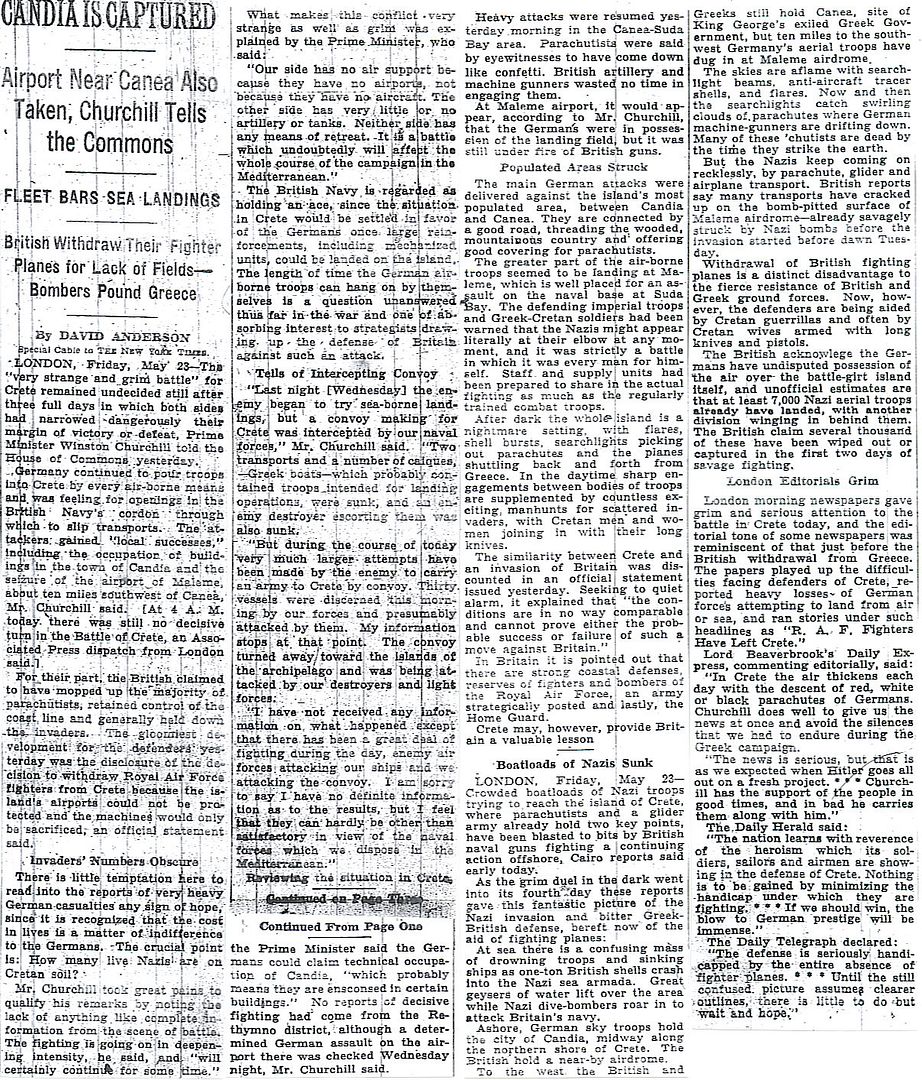
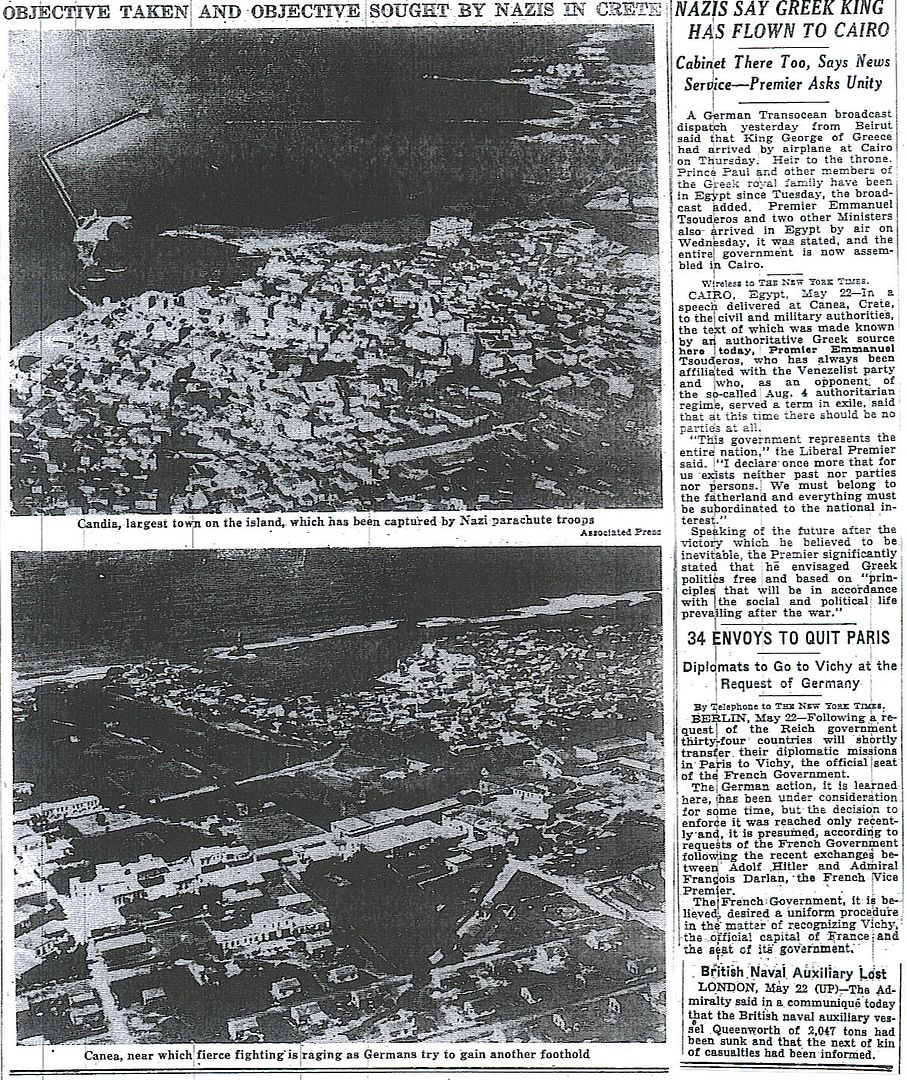

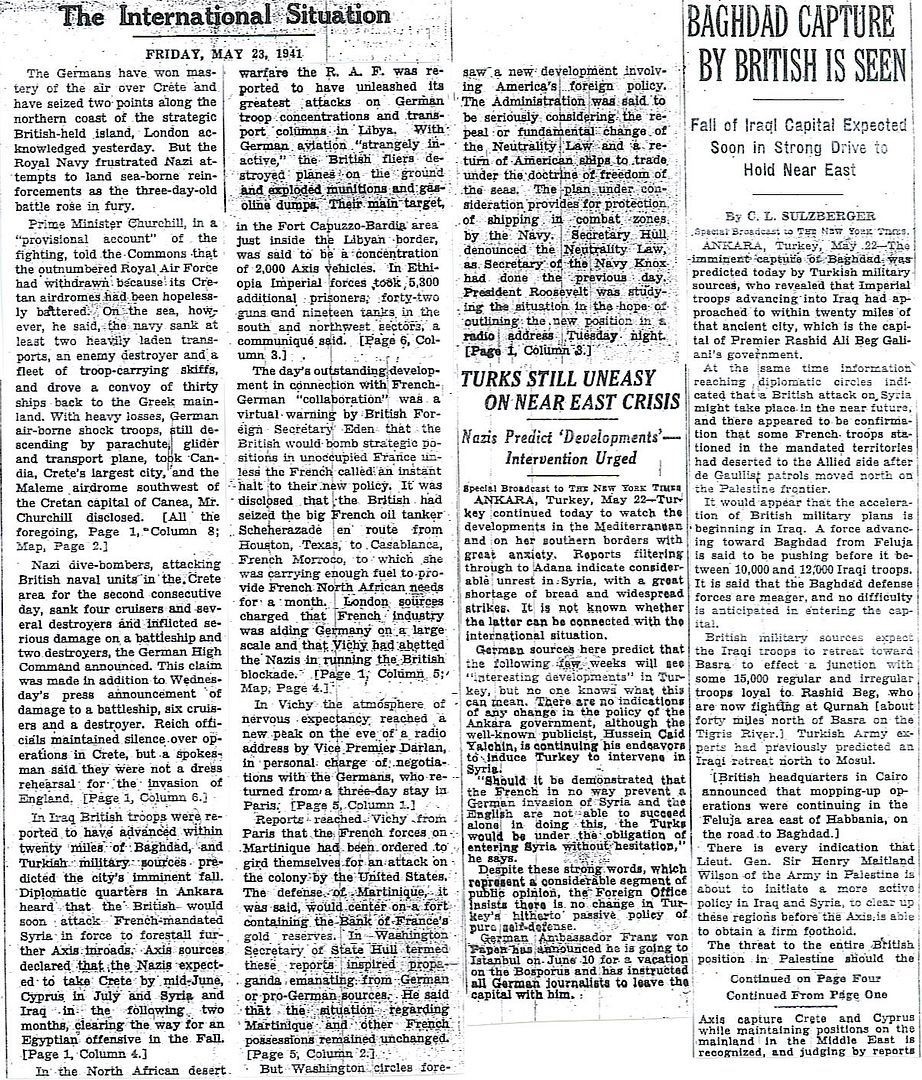
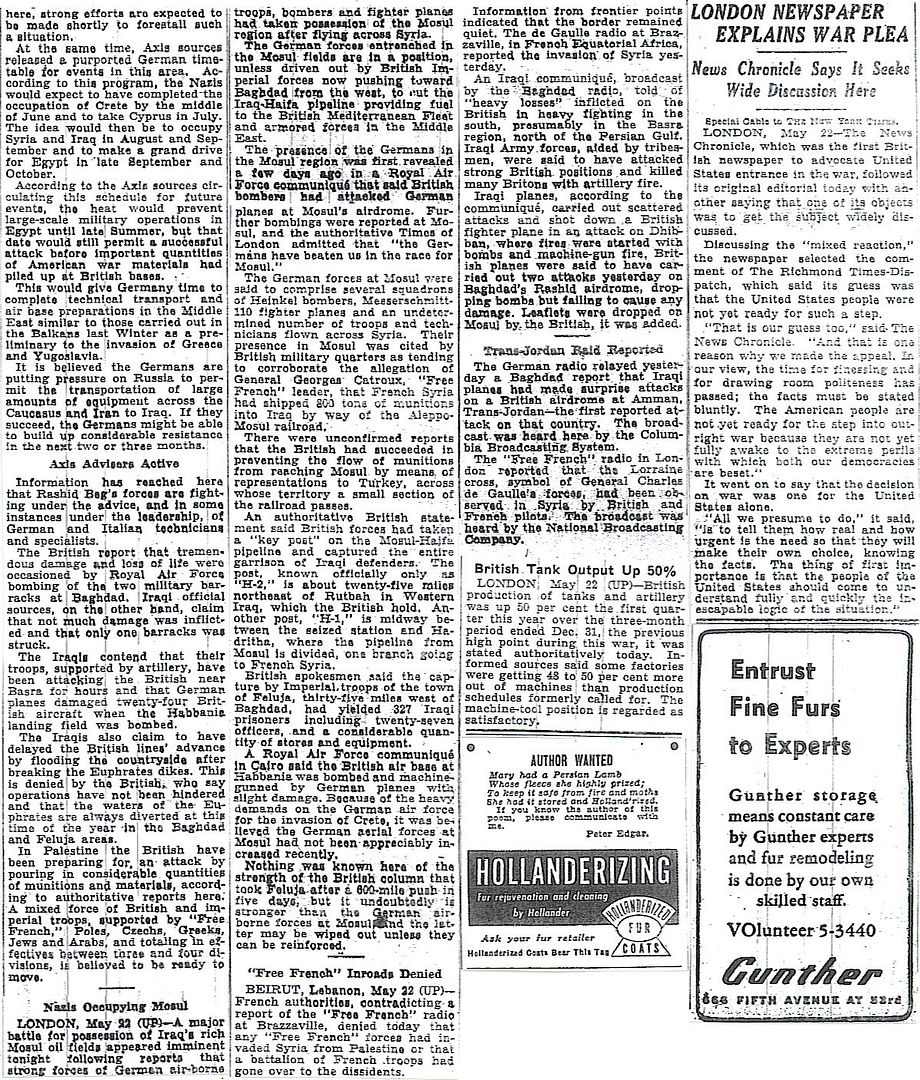
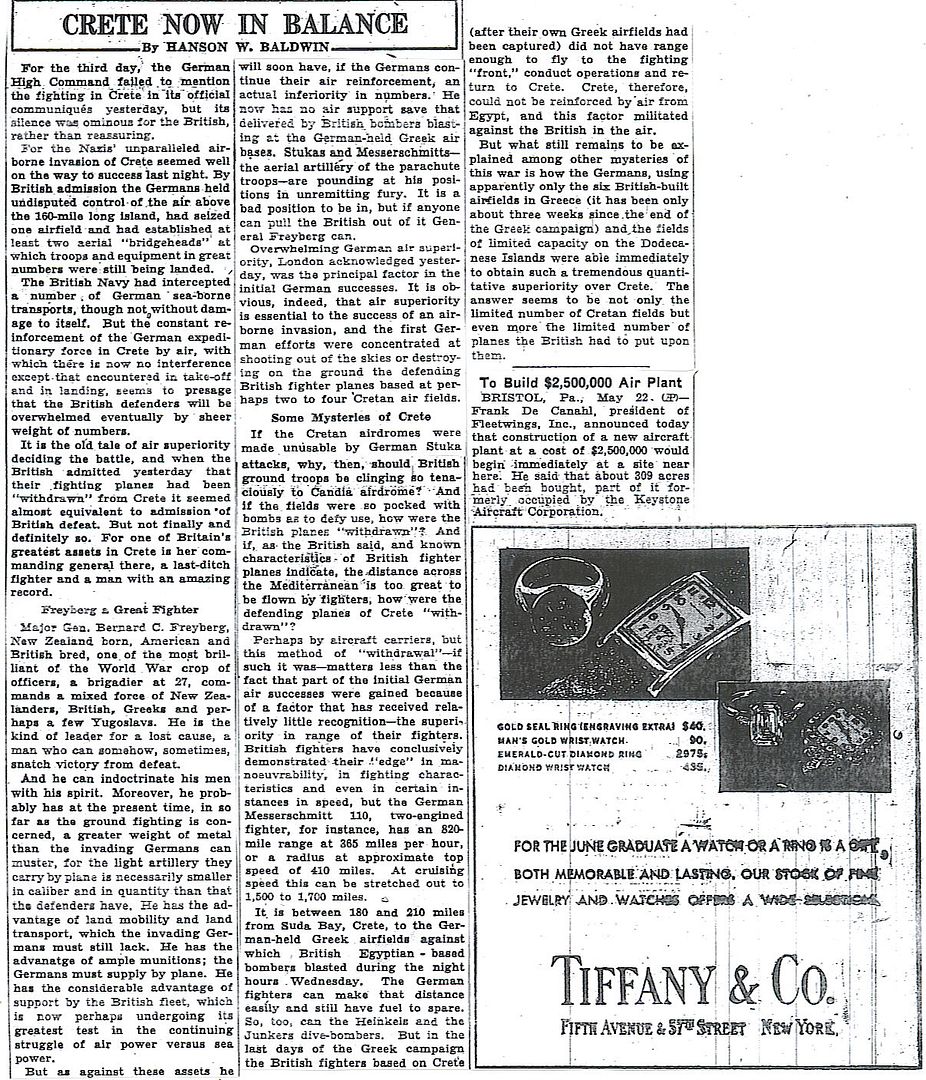
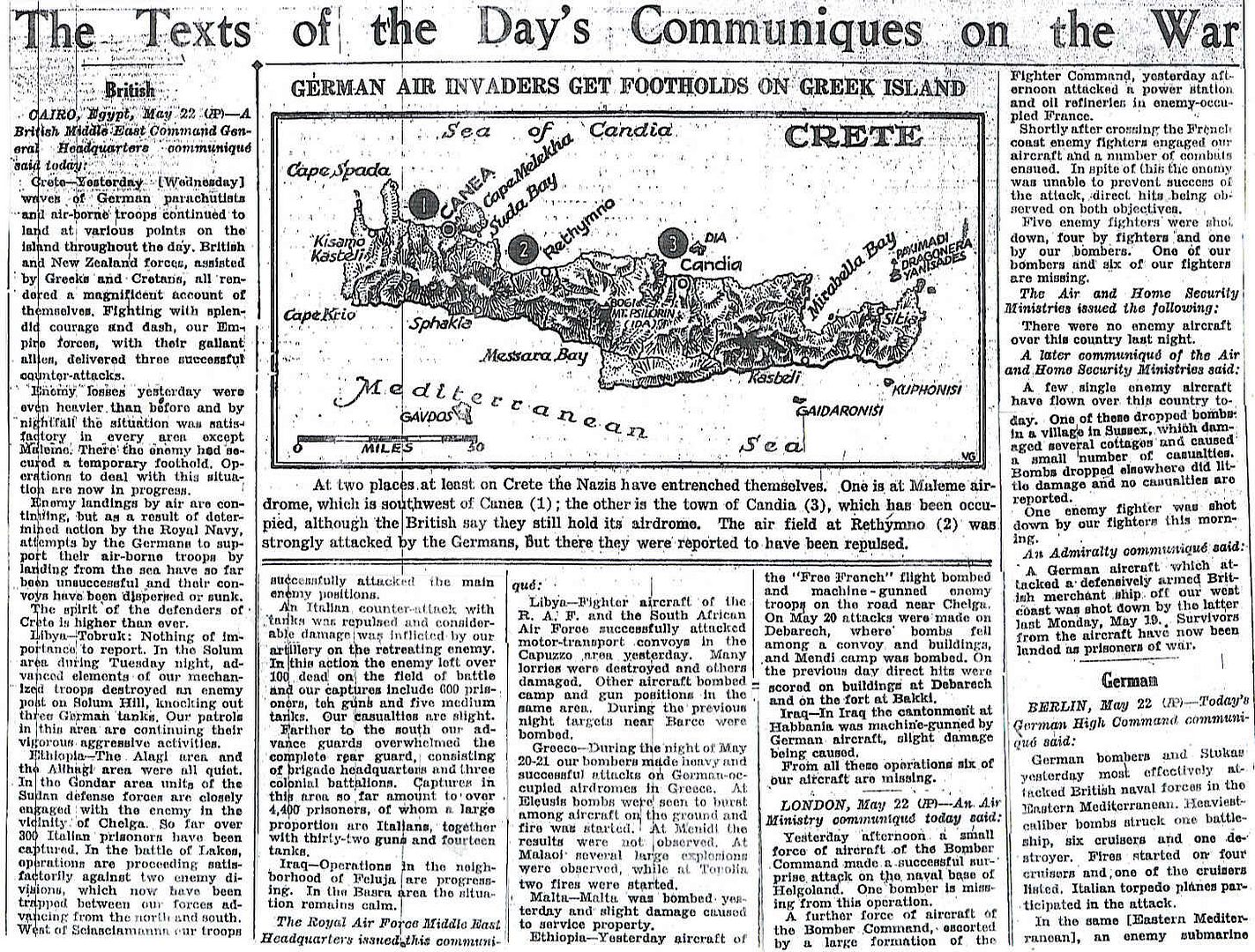
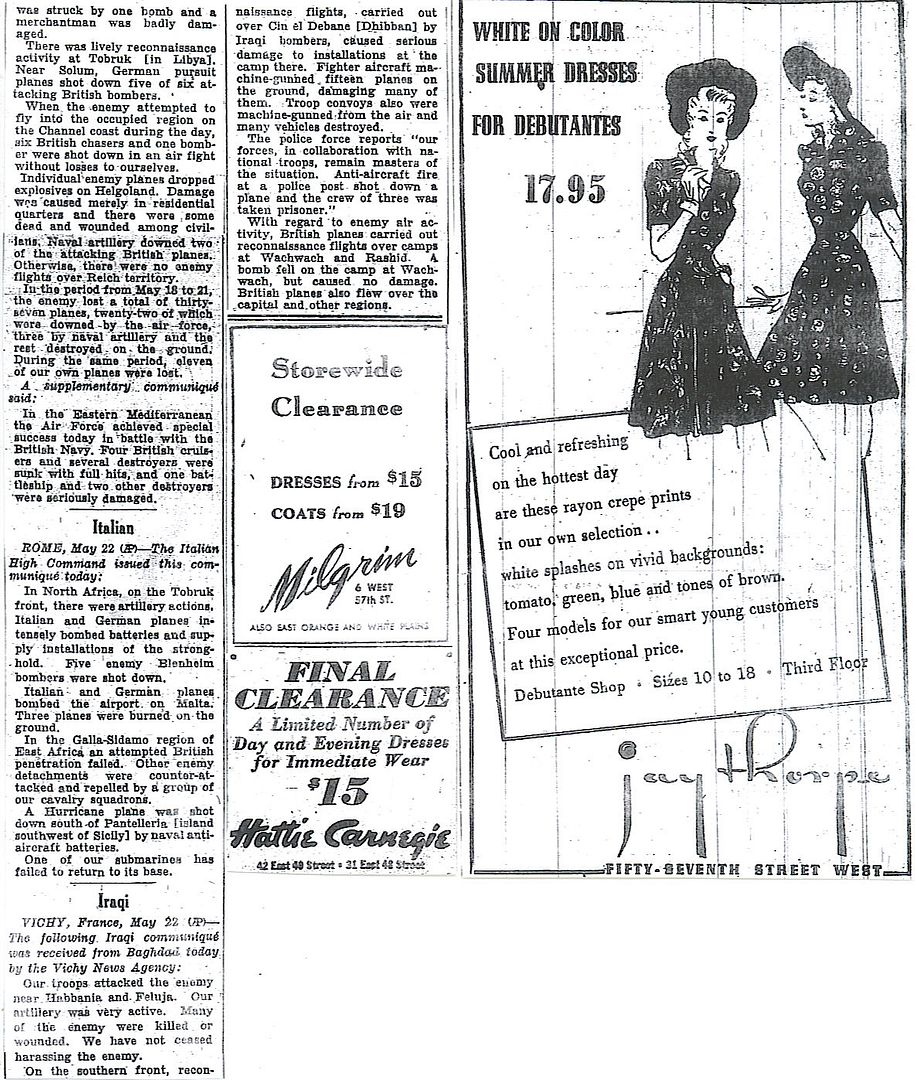
http://www.kbismarck.com/histoperi.html
23 May 1941 (Friday):
0400. New course 250º. Speed 27 knots.
1200. Position 67º 28’ North, 19º 28’ West. Course 250º. Average speed 24 knots.
1420. Course 270º.
1811-1822. False alarm. Vessels identified as icebergs.
1821. Bismarck and Prinz Eugen reach the ice limit. New course set at 240º.
1922. Sights Suffolk on her port side at 7 miles.
2030. Bismarck sights Norfolk and fires five main battery salvoes. No hits scored. The forward radar set (FuMO 23) is disabled due to the blast shock from the forward turrets. Shortly afterwards the Prinz Eugen passes the Bismarck and takes the lead.
2200. Reverses her course and tries to engage the Suffolk which realizes the Bismarck’s manoeuvre and withdraws.
http://www.kbismarck.com/operheini.html
On 23 May the weather remained the same. At 1811 in the afternoon, the Germans sighted ships to starboard, but soon realised they were actually icebergs which were common in those latitudes. Meanwhile, the battle group reached the ice limit, and set a course of 240º. At 1922, the Bismarck and Prinz Eugen were sighted by the British heavy cruiser Suffolk at a distance of seven miles.4 The Suffolk sent an enemy report: “One battleship, one cruiser in sight at 20º. Distance sevn miles, course 240º.” The Germans had detected the British cruiser as well, but were unable to engage the enemy because the Suffolk took cover in the fog. About an hour later, at 2030, the Germans sighted the British heavy cruiser Norfolk, and this time the Bismarck opened fire immediately. She fired five salvos, three of which straddled the Royal Navy ship throwing some splinters on board. The Norfolk was not hit by any direct impact, but had to launch a smoke screen and retire into the fog. The British cruisers then took up positions astern of the German ships; the Suffolk (equipped with a new Type 284 radar) on the starboard quarter, and the Norfolk (with an old Type 286M radar) on the port quarter. Both ships would keep R. D/F (radio direction-finding) contact and report the Germans’ position until more powerful British ships could engage.
On board the Bismarck the forward radar instrument (FuMO 23) had been disabled by the blast of the forward turrets. Because of this, Admiral Lütjens ordered his ships to exchange positions and the Prinz Eugen with her radar sets (FuMO 27) intact took the lead. Bismarck’s powerful artillery would serve to keep the British cruisers from coming any closer. This change would produce great confusion for the British the next morning.
After being sighted by cruisers Suffolk and Norfolk, Lütjens could have then turned around and head for the Norwegian Sea in order to refuel from tanker Weissenburg. He had already done this earlier that year when in command of Scharnhorst and Gneisenau his force was detected by the British cruiser Naiad in the Faeroes-Iceland gap. An early retreat at this point would have forced the four British capital ships (Hood, Prince of Wales, King George V and Repulse) that had already put to sea, to go back to Scapa Flow with a considerable expenditure of fuel. This time however, Lütjens continued towards the Atlantic with the hope of shaking off the British cruisers at night. The weather conditions in the Denmark Strait were favourable to do so. When Lütjens decided to press on, it is probably because he believed that the heavy units of the Home Fleet were too far away to intercept him, and that they may still be in Scapa Flow. The German reconnaissance reports seemed to confirm this, although the truth is that Vice-Admiral Holland’s force was already approaching the area at high speed. Another thing Lütjens did not count on was the effective use of British radars. At about 2200, the Bismarck reversed her course trying to catch the Suffolk, but the British cruiser withdrew maintaining the distance. Therefore, the Bismarck returned to the formation behind the Prinz Eugen.
http://www.onwar.com/chrono/1941/may41/f23may41.htm
German exploiting gains on Crete
Friday, May 23, 1941 www.onwar.com
In the Mediterranean... On Crete, the Germans continue to exploit their hold on Maleme, sending in artillery units and fighter aircraft. In the naval battles offshore, the destroyers Kelly and Kashmir (part of Lord Mountbatten’s 5th Destroyer Flotilla) are sunk by the Germans while they are withdrawing.
In the North Atlantic... The German battleship Bismark and her consort, Prinz Eugen, are sighted in the Denmark Strait by the patrolling British cruisers Norfolk and Suffolk. British radar equipment plays an important part in the interception.
http://www.hmshood.com/history/timeline4.htm
23 May: Bismarck and Prinz Eugen sighted by H.M.S. Suffolk in Denmark Strait between Greenland and Iceland.
http://www.hmshood.com/history/denmarkstrait/bismarck1.htm
Norfolk and Suffolk’s Patrol in the Denmark Strait
RADM Wake-Walker had arranged for Suffolk to join him at Isafjordur on the north west coast of Iceland after she had completed her refuelling. The two cruisers would then commence their patrol of the Denmark Strait. Their role would, of course, be to locate Bismarck and Prinz Eugen and keep contact with them – there was no question of Wake-Walker’s ships engaging the German squadron as they would be clearly outgunned. The cruisers would patrol down the Strait in a south westerly direction and then reverse course towards the north west. This would continue until the German ships were seen or enough time had elapsed to ensure that they were not heading out into the Atlantic via this route. It was always possible of course that the German ships would be located using another route and that Wake-Walker would be called to assist.
The patrol began mid-morning of 23 May. Both cruisers were fitted with radar equipment (R D/F) but that on Suffolk was far superior to that on Norfolk. Suffolk’s radar was multi-directional with a range of 13 miles which enabling her to sweep in all directions except a blind spot at her stern. In contrast Norfolk was fitted with fixed R D/F allowing her to see ahead only. For this reason Suffolk was chosen to patrol on the Greenland side of the Strait. She would keep the ice at the limit of her radar, which would allow her room for manoeuvre should the German ships be sighted. This protection was further enhanced by the fog conditions that day – it was clear over Greenland and the ice pack, but a bank of fog was clinging to the Icelandic coast. This fog would provide a blanket of protection into which the British ships could slip once contact with the enemy was established. Norfolk, with her fixed equipment, patrolled from the Iceland side of the Strait only.
The patrol continued throughout the day and into the early evening. At roughly 1915 hours, whilst Suffolk was on her south-westerly run, the uncertainty was suddenly ended: Able Seaman Newell was on duty as the starboard after look out. He was there to cover the ‘blind’ zone in Suffolk’s radar coverage astern. As he scanned the horizon he saw Bismarck, and then Prinz Eugen roughly 7 miles away. He immediately called out ‘Ship bearing green one four oh’, followed seconds later by ‘two ships bearing green one four oh’. The reaction was swift as Suffolk heeled over to port to seek the cover of the fog bank. Further encouragement was found by the fact that Bismarck did not open fire on Suffolk. Signals were sent out to say that contact with the enemy had at last been made.
Norfolk, hiding within the safety of the fog, picked up Suffolk’s report. She steered to take up position at the edge to the fog to assist in keeping contact. She strayed too close to the edge of the fog bank however, and cover was briefly lost. Bismarck spotted her and immediately opened fire. Norfolk was straddled, but was able to safely regain the cover of the fog bank. It was the first time the new German battleship had fired salvoes in anger and it served as a warning to the British of the deadly accuracy of Bismarck’s guns.
Luck seemed to be running with the British: Contact with the enemy squadron had been achieved. Although the Germans knew that they been found, neither British ship had been damaged in making contact. Furthermore, contact could be safely maintained by means of Suffolk’s radar from the cover of the fog bank. It was now just a question of ensuring that British heavy ships could be guided towards the enemy.
Hood Leads the Chase
By 2000 hours, Hood’s force was at 63º20N’ 27º00’W. Shortly before this, at 1939 hours, Vice-Admiral Holland ordered his vessels to raise steam for full speed and to change course to 295º. Shortly thereafter, at 2004 hours, he had the news he had been waiting for: Suffolk had positively sighted Bismarck and its consort in the Denmark Strait. This was followed-up by a report from Norfolk at 2040 hours. Plots put the Germans approximately 300 miles to the north of Holland’s force.
Holland’s battle plan at this point appears to have been for Hood and Prince of Wales to engage Bismarck in one of two fashions:
a. The first option was to cross the Germans’ “T” - i.e., cut across their bows on a westward course whilst they headed south. This would allow all the British guns to bear on the German ships whilst the enemy would only be able to fire at the British squadron with their forward guns. Of course, such a move could be easily countered.
b. The second choice was for Holland’s ships to cross the German squadron’s path well ahead, then swing around and approach from the west. This would would silhouette the Germans against the morning sky and considerably ease range finding for the British. It is evident that VADM Holland was hoping that Norfolk and Suffolk would engage Prinz Eugen whilst the two British capital ships fired on Bismarck, though this was evidently never communicated to them.
By 2054 hours, Hood’s force was proceeding at 27 knots on a heading of 295º. As the speed increased, the destroyers struggled to maintain station in the heavy seas. VADM Holland signalled to the destroyers “If you are unable to maintain this speed, I will have to go on without you. You should follow at your best speed”. The four tiny destroyers did their best to keep up with the old battle cruiser fairly but took a horrendous buffeting in doing so.
At 2200 hours, the crews of Hood, Prince of Wales and their accompanying destroyers were officially notified of the Germans presence in the Denmark Strait. Interception and action was expected to take place between 0140 and 0200 hours that morning. All hands were ordered to be prepared to change into clean undergarments (to help prevent infection should they be wounded) and to don battle gear (life vests, flash gear, gas masks, helmets and, where necessary, cold weather gear). At 2230 hours, ‘darken ship’ was ordered. By 0015 hours, 24 May, crews aboard both ships had been called to action stations and battle ensigns raised (note- Hood raised one battle ensign only). They were then an estimated 120 miles / 222 km south of the German ships.
http://homepage.ntlworld.com/andrew.etherington/month/thismonth/23.htm
May 23rd, 1941
UNITED KINGDOM: The “black propaganda” station GS1 makes its first broadcast to Germany, calling Churchill a “flat-footed bastard of a drunken old Jew.” (More on German propaganda radio stations.)
London:
The Admiralty invites the governments of Canada and Newfoundland to use St. John’s, Newfoundland as an advanced base for joint escort services. This will enable continuous naval escort over the whole of the north Atlantic route.
In May 1941, the enemy started dropping a new type of mine, known as ‘G’ type, which had no parachute and which if it did not explode on impact, buried itself deeply in the ground (twenty to thirty feet or more). On 22 May 1941, Lt Frederick Ronald Bertram Fortt, RNVR, and Lt Denis James Patrick O’Hagan RCNVR were sent to Nuneaton to deal with one of the first ‘G’ mines dropped on land and unexpended. It was already known that it contained a new anti-handling mechanism activated by a photo-electric cell, which would explode when exposed to daylight and it was necessary to remove the unit of the mine containing this device before the mine would be safe to handle. Instruction showed that it was necessary to work in darkness and also that the mine would probably be magnetically alive and sensitive to any magnetic influence. The Nuneaton Bomb Disposal Squad (Lt R.A. McClune) volunteered to work on the preliminary heavy excavation, up to the point of locating the mine. The mine was found at twenty-two feet and Fortt and O’Hagan freed the end from the surrounding sub-soil; then widened the bottom of the shaft sufficiently for the necessary operations to be carried out upon the magnetic unit. The soil being in the form of petrified clay, work could only be carried out with picks and shovels regardless of any effect which the vibrations would have upon the mechanism of the mine — then very largely and unknown quantity. To add to the difficulties, those parts which had to be removed in the early and most dangerous stages of the operation were very heavy, in practice too heavy for one man alone — this was why two officers were sent. Working in the dark, they successfully removed the magnetic unit and primer and, after further excavation, the fuse. Dealing with an unknown mine, courage of a very high order is required. The operation was brought to a successful conclusion. Fortt has been in Land Incident Section for eight months and has dealt with thirty mines. O’Hagan for ten months and has dealt with twenty-three mines.
Authorization of construction or acquisition of 550,000 tons of auxiliary shipping for Navy. (Dave Shirlaw)
FRANCE: Admiral Darlan tells why France chose collaboration freely. For “ameliorations of the consequences of defeat and of the conditions of the armistice. . . . It is necessary for her to choose between life and death. The Marshal and the Government have chosen life”. (Dave Shirlaw)
GERMANY: Göring issues a directive for economic exploitation of the USSR, in which he says that famine and the deaths of millions of Russians are inevitable.
Hitler orders military support for Rashid Ali’s rebels in Iraq.
GREECE: CRETE: King George of the Hellenes flees to Egypt.
Destroyer HMS Kelly (commanded by Captain Lord Louis Mountbatten, second cousin of King George VI and the only man other than the King to hold rank in all three military services simultaneously) in company with HMS Kashmir is attacked by a force of 24 Ju.87 dive-bombers. Kelly is struck amidships by a single bomb whilst turning under full helm at 30 knots and rolls over to port. She remains afloat upside down for half an hour before sinking 13 miles south of Crete at 34 40N 24 10E. There are 128 survivors, including Mountbatten who is thrown in to the Mediterranean.Mountbatten was still on the bridge of the ship when it finally flipped over; nevertheless, he managed to swim to shore and take control of the rescue operation.
Destroyer HMS Kashmir (in company with Kelly) sinks within two minutes of the air attack. There are 153 survivors who are rescued by HMS Kipling which is also attacked, but escapes by some nifty handling. It leaves her so short of fuel that net layer HMS Protector has to be sent out from Alexandria to supply her with fuel. Kipling lands 281 survivors from both destroyers. (Alex Gordon)(108)
Many of the survivors are rescued by HMS Kipling after being machine-gunned in the water.
HMS Hasty (Capt. Nigel Austen) in company with HMS Hotspur sink U-79 after a a long and determined pursuit in which both warships almost exhausted their supply of depth charges. For this Capt. Austen will receive his first DSO and a personal visit from the Commander-in-Chief, Admiral Sir Andrew Cunningham, who is delighted at this first U-boat kill in the eastern Mediterranean.
MEDITERRANEAN SEA: Gunboat FS Meuliere wrecked off Ajjacio, Corsica. (Dave Shirlaw)
CANADA: HMCS Woodstock laid down Collingwood, Ontario. (Dave Shirlaw)
NEWFOUNDLAND: Newfoundland Command and Newfoundland Escort Force (NEF) established. There were virtually no naval facilities in existence in St. Johns and initially, ships of the Royal Navy provided from operational support alongside. The RN auxiliary oiler Teakwood arrived on 29 May and the stores ship City of Dieppe arrived on 03 Jun. A second oiler, Clam, arrived on 9 Jun and on 14 Jun the submarine depot ship FORTH arrived. She was replaced in Sep by the destroyer depot ship Greenwich, which, despite her smaller size and greater age, was more suited to the needs of the NEF. A Great Lakes passenger steamer, known as HMCS Avalon II, was added to serve as an afloat barracks. Cmdre Leonard Warren Murray RCN arrived to assume command on 15 Jun. For a number of months his entire staff consisted of his deputy, Cdr Robert Edward Bidwell RCN (who did not arrive until Jul 41), and his flag secretary. The first escort of a convoy by the NEF was quickly undertaken on 02 Jun when HMC ships Chambly, Orillia and Collingwood put to sea to join with the 57-ship Halifax to Liverpool Convoy HX-129. This convoy, which left Halifax on 27 May, was the first to have continuous close escort all the way across the Atlantic. It arrived safely in Liverpool on 12 Jun 41.
Corvette HMCS Quesnel commissioned.
Destroyer HMCS Saguenay departed Greenock for St John’s.
Corvettes HMCS Aggasiz, Alberni, Chambly, Cobalt, Collingwood, Orillia and Wetaskiwin departed Halifax for St John’s to join Newfoundland Escort Force.
(Dave Shirlaw)
U.S.A.: Submarine USS Grampus commissioned. (Dave Shirlaw)
ATLANTIC OCEAN: In the early evening, heavy cruisers HMS Suffolk and shortly HMS Norfolk sight BISMARK and Prinz Eugen north west of Iceland and shadow them southwestwards through the Denmark Strait. HMS Hood and HMS Prince of Wales, escorted by destroyers HMS Electra, HMS Anthony, HMS Echo, HMS Icarus, HMS Achates and HMS Antelope, press on to intercept west of Iceland.
HMS Ark Royal, Renown and Sheffield, accompanied by HMS Faulknor, Foresight, Forester, Fortune, Foxhound and Fury, are dispatched to the Atlantic to search for BISMARK.
At 1951, the Berhala was hit by one torpedo from U-38 in the engine room at the port side, killing the third engineer, the fifth engineer and the donkeyman 1st class. The port lifeboat was destroyed and immediately after the hit Chinese crewmembers cut through the ropes of the other lifeboat and rowed away in it. At 2020 a second torpedo struck the vessel and the remaining crewmembers had to jump overboard, because the ship sank within eight minutes about 250 miles off Freetown. Shortly after the sinking, the survivors were picked up by a British warship and taken to Freetown.
During heavy weather in the North Atlantic, a lookout on U-46 broke his arm. (Dave Shirlaw)
http://worldwar2daybyday.blogspot.com/
Day 631 May 23, 1941
Crete. Overnight, British destroyers HMS Kelly (captained by Lord Louis Mountbatten, 2nd cousin of King George VI) and HMS Kashmir shell German positions at Maleme airfield. They retire 35 miles South of Crete but they are sunk by Stukas at 8 AM (181 killed). Destroyer HMS Kipling rescues 297 survivors, including Mountbatten, but is then badly damaged by HMS Kelly as she sinks (under repair at Alexandria, Egypt, until June). More German troops are airlifted into Maleme airfield along with artillery, securing the entire West end of the island. Paratroops push along the North coast against the British and ANZACs while mountain troops tackle the hilly backbone of the island held by poorly-armed Greek troops and Cretan guerrillas. 5 British motor torpedo boats are sunk by German bombing at Suda Bay.
Operation Rheinübung. At 7.22 PM, German battleship Bismarck and cruiser Prinz Eugen are spotted by British cruisers HMS Suffolk and HMS Norfolk in the Denmark Strait. After HMS Norfolk is almost hit by shellfire from Bismarck, both cruisers retire to a safe distance. They shadow the German warships using radar while battleship HMS Prince of Wales and battlecruiser HMS Hood close in from 300 miles to the South.
At 8.20 PM 200 miles off Guinea, West Africa, U-38 sinks Dutch MV Berhala (3 dead, 59 survivors rescued by a British warship).
http://en.wikipedia.org/wiki/HMS_Norfolk_%2878%29
but by May she had returned to Icelandic waters. Norfolk was the second ship to sight the Bismarck. She and the earlier County class HMS Suffolk continued to dog the German battleship and were part of the force with Rodney and King George V that sank her.
http://en.wikipedia.org/wiki/HMS_Suffolk_%2855%29
During May 1941 Suffolk was involved in the Battle of the Denmark Strait and the sinking of the German battleship Bismarck. Suffolk had engaged the battleship twice during the battle, making several salvoes on her. Using her radar, Suffolk was able to track the Bismarck through the Denmark Strait and maintained contact long enough for other units to vector into Bismarcks path.

The Captain on the bridge of HMS SUFFOLK while shadowing BISMARCK. The Captain does not leave the bridge on these occasions; here he is seen having a sandwich for his lunch.
http://en.wikipedia.org/wiki/HMS_Kelly_%28F01%29
HMS Kelly (pennant number F01) was a K-class destroyer of the British Royal Navy, and flotilla leader of her class. She served through the early years of the Second World War; in Home Waters, off Norway and in the Mediterranean. Throughout her service, Kelly was commanded by Lord Louis Mountbatten. She was lost in action in 1941 during the Battle of Crete. In addition, Mountbatten served as commander (Captain (D)) of the 5th Destroyer Flotilla.
On 23 May 1941, during the evacuation of Crete, Kelly was bombed and sunk, with half her crew killed. Kelly did succeed in shooting down one of the attacking Stukas immediately, while another was badly damaged and crashed upon returning to base.[4] The survivors were deeply affected by the loss of their ship; Mountbatten shared their loss and tried to console the ship’s company by reminding them all that “we didn’t leave the Kelly, the Kelly left us!”
The 1942 film In Which We Serve starring Noel Coward and John Mills and telling the story of “HMS Torrin”, is based on the career of Kelly.
Mountbatten did a great documentary series before he was by murdered by the IRA, included him speaking with the survivors of the HMS Kelly at a reunion.
The sad thing about Crete is that it was so close. The Germans only captured the island due to phenomenal luck. The British and Greeks could have very easily kept it. Had they done so, they would have destroyed Germany’s airborne forces, kept a notable chunk of Greek soil still under the Greek government (this may have prevented the Greek Civil War), and given the allies a major airbase close to Southeast Europe.
About the same time, the radar operators on Suffolk saw that the German ships had changed course. The Bismarck had reversed course in an attempt to attack or drive off the two shadowing cruisers. The radar gave the British ships warning, and they simply slipped away under cover of the fog. Unable to spot them, the Bismarck resumed her original course, with Prinz Eugen still leading. The British cruisers resumed their position astern of her, but two hours later, just after midnight, a snowstorm temporarily blinded Suffolk's radar. All the operator saw was a blur. By coincidence Admiral Lutjens chose roughly rhe same moment to increase speed. As a result the German slipped ahead under cover of the snowstorm, and the British cruisers lost contact. It was a full three hour before radar contact was regained.
In the meantime Holland altered course to 240 degrees - the south-west - in case the Germans changed course as well as speed. That way he was surer of an interception, only that it would take place a little after dawn. As Holland's force steamed west to intercept his crews went to action stations, where his men grabbed what seep they could. On the Prince of Wales, the few civilian contractors who were still on board worked through the night to sort out the mechanical problems that still plagued the main guns. As dawn approached, the lookouts peered through the darkness to starboard, waiting for the first sign of the enemy warships they knew were out there.
At 5.37am a lookout on board the Hood spotted smoke on the horizon.
At one point, the British had the battle won, but the New Zealand troops pulled back from their positions and gave the Germans uncontested control of the Máleme airfield (and later the blocking position at Galatas). Perhaps if the British had not treated them so badly in previously campaigns, they might have had a bit more resolve and held the position.
So Lt. Col. Leslie Andrew (who had won the VC in World War I) is responsible for a large portion of the German 'luck'. Although he served in N. Africa until Feb, 1942, he spent a large chunk of the rest of the war defending Wellington, NZ where he could do no further damage.
Disclaimer: Opinions posted on Free Republic are those of the individual posters and do not necessarily represent the opinion of Free Republic or its management. All materials posted herein are protected by copyright law and the exemption for fair use of copyrighted works.